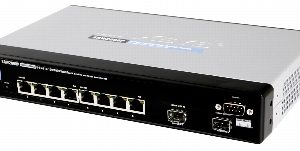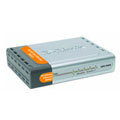For wireless or voice over IP (VoIP) deployments, the Cisco SFE2010P supports the IEEE 802.3af standard for Power over Ethernet (PoE). Automatic load sensing in the power-control circuitry detects PoE on the end device before providing power. For safety, each port has independent overload and short-circuit protection, along with LED indicators to show power status. The switch provides 15W of available PoE power on up to 24 of the Fast Ethernet ports for powering PoE-enabled wireless access points or VoIP handsets. The maximum PoE available per switch for all ports is 360W
The Cisco SFE2010P provides resilient stacking for up to four units, or 192 ports. A stack of units is managed as a single switch with one web management interface. The SFE2010P switch can coexist in a stack with the Cisco SFE2000 and SFE2000P 24-Port 10/100 Ethernet Switches and the Cisco SFE2010 48-Port 10/100 Ethernet Switch, for a maximum of 192 ports in a stack. The stacking capability includes master/backup unit behavior, ring and chain architecture, and hot insertion and removal of units.
Software running on the Cisco SFE2010P switch interacts with provisioning, management, and security software on both the site’s services router and the service provider’s equipment. This interaction provides simple, one-step installation and access to web-administered features for the administrator and users. Simple, affordable network operations throughout the network’s lifetime are the result.
Highlights
• Connects up to 48 network devices – PCs, printers, and servers – to share and transfer files and videos across your network
• Resilient Clustering provides the ability to add more switches as needed to support growing business with capability to manage a stack as a single switch
• Power over Ethernet easily and cost-effectively powers wireless access points, video cameras, and other network-connected endpoints
• Advanced security protects network traffic to keep unauthorized users off the network
• Limited lifetime warranty
Features
• Forty-eight 10/100 Ethernet ports
• Two 10/100/1000 Ethernet ports (used as stacking ports if operated in stacking mode)
• Two mini Gigabit Interface Converter (mini-GBIC) slots for fiber Gigabit Ethernet expansion
• IEEE 802.3af PoE delivered over any of the forty-eight 10/100 ports
• 15.4W available power to the Fast Ethernet ports for PoE-enabled wireless access points or VoIP handsets (maximum per-switch PoE delivery of 360W available for all ports)
• Dual images for resilient firmware upgrades
• 17.6-Gbps, nonblocking, store-and-forward switching capacity
• Simplified QoS management enabled by queuing techniques using 802.1p, Differentiated Services (DiffServ), or type of service (ToS) traffic prioritization
• Fully resilient stacking for optimized growth with simplified management
• ACLs for granular security and QoS implementation
• Configuration and monitoring from a standard web browser
• Secure remote management of the switch via Secure Shell (SSH) and SSL encryption
• 802.1Q-based VLANs enable segmentation of networks for improved performance and security
• Private VLAN Edge (PVE) simplifies network isolation of guest connections or autonomous networks
• Automatic configuration of VLANs across multiple switches through Generic VLAN Registration Protocol (GVRP) and Generic Attribute Registration Protocol (GARP)
• User/network port-level security via 802.1X authentication and MAC-based filtering
• Increased bandwidth and added link redundancy with Link Aggregation Control Protocol (LACP)
• Enhanced rate-limiting capabilities, including back pressure and multicast and broadcast flood control
• Port mirroring for noninvasive monitoring of switch traffic
• Mini jumbo frame support (1632 bytes)
• Simple Network Management Protocol (SNMP) versions 1, 2c, and 3 and Remote Monitoring (RMON) support
• Fully rack mountable using included rack-mounting hardware
Specifications
|
Feature
|
Description
|
|
Specifications
|
|
Ports
|
48 RJ-45 connectors for 10BASE-T/100BASE-TX; two 10BASE-T/100BASETX/1000BASE-T ports; 2 mini-GBIC ports; console port; auto medium dependent interface (MDI) and MDI crossover (MDI-X); auto negotiate/manual setting; RPS port for connecting to redundant power supply unit
|
|
Buttons
|
Reset button
|
|
Cabling type
|
Unshielded twisted pair (UTP) Category 5 or better for 10BASE-T/100BASE-TX; UTP Category 5e or better for 1000BASE-T
|
|
LEDs
|
PWR, Fan, Link/Act, PoE, Speed, RPS, Master, Stack ID 1 through 8
|
|
Power over Ethernet
|
|
• IEEE 802.3af PoE delivered over any of the forty-eight 10/100 ports
• Maximum power of 15.4W to a Fast Ethernet port – 360W total available to all Fast Ethernet ports with regular AC power, 280W total available with a redundant power supply unit
|
|
Performance
|
|
Switching capacity
|
17.6 Gbps nonblocking
|
|
Forwarding capacity
|
13 mpps (64-byte packets)
|
|
Stacking
|
|
Stack operation
|
• Up to 192 ports in a stack
• Hot insertion and removal
• Ring and chain stacking options
• Master and backup master for resilient stack control
• Auto-numbering or manual configuration of units in stack
|
|
Layer 2
|
|
MAC table size
|
8000
|
|
Number of VLANs
|
256 active VLANs (4096 range)
|
|
VLAN
|
Port-based and 802.1Q tag-based VLANs, protocol-based VLAN, management VLAN, multicast TV VLAN, PVE, GVRP
|
|
Head-of-line (HOL) blocking
|
HOL blocking prevention
|
|
Layer 3
|
|
Layer 3 options
|
Static routing; classless interdomain routing (CIDR); 60 static routes; IPv4; forwarding in silicon – wire-speed forwarding of Layer 3 traffic
|
|
IPv6
|
|
IPv6
|
IPv6 Host Mode
IPv6 over Ethernet
Dual IPv6/IPv4 stack
IPv6 Neighbor and Router Discovery (ND)
IPv6 Stateless Address Autoconfiguration
Path MTU Discovery
Duplicate Address Detection (DAD)
ICMPv6
IPv6 over IPv4 network with ISATAP tunnel support
|
|
IPv6 QoS
|
Prioritize IPv6 packets in hardware
|
|
IPv6 ACL
|
Drop or Rate Limit IPv6 packets in hardware
|
|
MLD Snooping
|
Deliver IPv6 multicast packets only to the required receivers
|
|
IPv6 Applications
|
Web/SSL, Telnet Server/SSH, Ping, Traceroute, SNTP, TFTP, Radius, Syslog, DNS Client
|
|
IPv6 RFCs Supported
|
RFC2463 – ICMPv6
RFC3513 – IPv6 Address architecture
RFC 4291 – IP Version 6 Addressing Architecture
RFC 2460 – Internet Protocol v6 (IPv6) Specification
RFC 2461 – Neighbor Discovery for IPv6
RFC 2462 – IPv6 Stateless Address Auto-configuration
RFC 1981 – Path MTU Discovery
RFC 4007 – IPv6 Scoped Address Architecture
RFC3484 – Default address selection mechanism is described by RFC3484
RFC4214 – ISATAP tunneling
RFC4293 – MIB IPv6: Textual Conventions and General Group
RFC 3595 – Textual Conventions for IPv6 Flow Label
|
|
Management
|
|
Web user interface
|
Built-in web user interface for easy browser-based configuration (HTTP/HTTPS)
|
|
SNMP
|
SNMP versions 1, 2c, and 3 with support for traps
|
|
SNMP MIBs
|
RFC1213 MIB-2, RFC2863 interface MIB, RFC2665 Ether-like MIB, RFC1493 bridge MIB, RFC2674 extended bridge MIB (P-bridge, Q-bridge), RFC2819 RMON MIB (groups 1, 2, 3, and 9 only), RFC2737 entity MIB, RFC 2618 RADIUS client MIB, RFC 1215 traps
|
|
RMON
|
Embedded RMON software agent supports 4 RMON groups (history, statistics, alarms, and events) for enhanced traffic management, monitoring, and analysis)
|
|
Firmware upgrade
|
• Web browser upgrade (HTTP/HTTPS) and TFTP
• Dual images for resilient firmware upgrades
|
|
Port mirroring
|
Traffic on a port can be mirrored to another port for analysis with a network analyzer or RMON probe.
|
|
Other management
|
Traceroute; single IP management; SSL security for web user interface; SSH; RADIUS; port mirroring; TFTP upgrade; Dynamic Host Configuration Protocol (DHCP) client; BOOTP; SNTP; Xmodem upgrade; cable diagnostics; Ping; syslog; Telnet client (SSH secure support)
|
|
Security
|
|
IEEE 802.1X
|
802.1X – RADIUS authentication, MD5 hash; guest VLAN; single/multiple host mode
|
|
ACLs
|
• Drop or rate limit based on source and destination MAC or IP address, protocol, port, VLAN, DSCP/IP precedence, TCP/ User Datagram Protocol (UDP) source and destination ports, 802.1p priority, Ethernet type, Internet Control Message Protocol (ICMP) packets, Internet Group Management Protocol (IGMP) packets, DHCP snooping, Address Resolution Protocol (ARP) inspection, and IP source address guard
• Up to 1018 rules
|
|
Availability
|
|
Link aggregation
|
Using IEEE 802.3ad LACP, up to 8 ports in up to 8 groups
|
|
Storm control
|
Broadcast, multicast, and unknown unicast
|
|
Spanning Tree
|
IEEE 802.1D Spanning Tree, IEEE 802.1w Rapid Spanning Tree, IEEE 802.1s Multiple Spanning Tree, and Fast Linkover
|
|
DoS prevention
|
DoS attack prevention
|
|
IGMP (versions 1 and 2) snooping
|
Limits bandwidth-intensive multicast traffic to only the requestors; supports 256 multicast groups
|
|
Quality of Service
|
|
Priority levels
|
4 hardware queues
|
|
Scheduling
|
Priority queuing and weighted round-robin (WRR)
|
|
Class of service
|
Port based; 802.1p VLAN priority based; IPv4/v6 IP precedence/ToS/DSCP based; DiffServ; classification and re-marking ACLs
|
|
Rate limiting
|
Ingress policer; egress rate control; per VLAN
|
|
Statistics
|
16 meters
|
|
Standards
|
802.3 10BASE-T Ethernet, 802.3u 100BASE-TX Fast Ethernet, 802.3ab 1000BASE-T Gigabit Ethernet, 802.3z Gigabit Ethernet, 802.3x flow control, 802.3ad LACP, 802.3af PoE, 802.1D Spanning Tree Protocol (STP), 802.1Q/p VLAN, 802.1w Rapid STP, 802.1s Multiple STP, 802.1X port access authentication
|
|
Environmental
|
|
Dimensions
W x D x H
|
17.32 x 14.70 x 1.73 in.
(440 x 375 x 44 mm)
|
|
Unit weight
|
10.89 lb (4.94 kg)
|
|
Power
|
100-240V 47-63 Hz, internal, universal; also equipped with external redundant power supply connector for external power supply, -48V DC
|
|
Certification
|
UL (UL 60950), CSA (CSA 22.2), CE mark, FCC Part 15 (CFR 47) Class A
|
|
Operating temperature
|
32° to 104°F (0° to 40°C)
|
|
Storage temperature
|
-4° to 158°F (-20° to 70°C)
|
|
Operating humidity
|
10% to 90%, relative, noncondensing
|
|
Storage humidity
|
10% to 95%, relative, noncondensing
|
|
Package Contents
|
|
• Cisco SFE2010P 48-Port 10/100 Ethernet Switch
• AC power adapter with power cord
• 2 rack-mounting kits with 8 screws
• CD-ROM with user documentation (PDF) included
• Registration card
• Console cable
|
|
Minimum Requirements
|
|
• Web browser: Mozilla Firefox version 1.5 or later; Microsoft Internet Explorer version 5.5 or later
• Category 5 Ethernet network cable
• TCP/IP, network adapter, and network operating system (such as Microsoft Windows, Linux, or Mac OS X) installed on each computer in the network
|
|
Product Warranty
|
|
Limited lifetime warranty with return to factory replacement, one year telephone support and software fixes for the warranty term.
|
 04 3550600
04 3550600 052 7036860
052 7036860 info@techsouq.com
info@techsouq.com





There are no reviews yet.